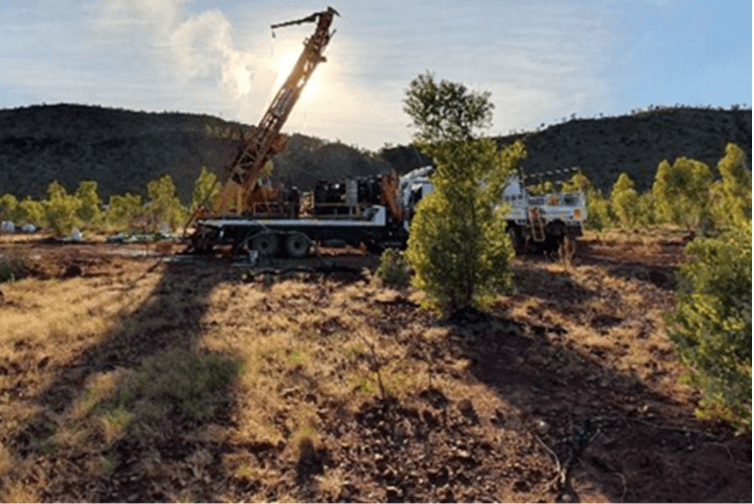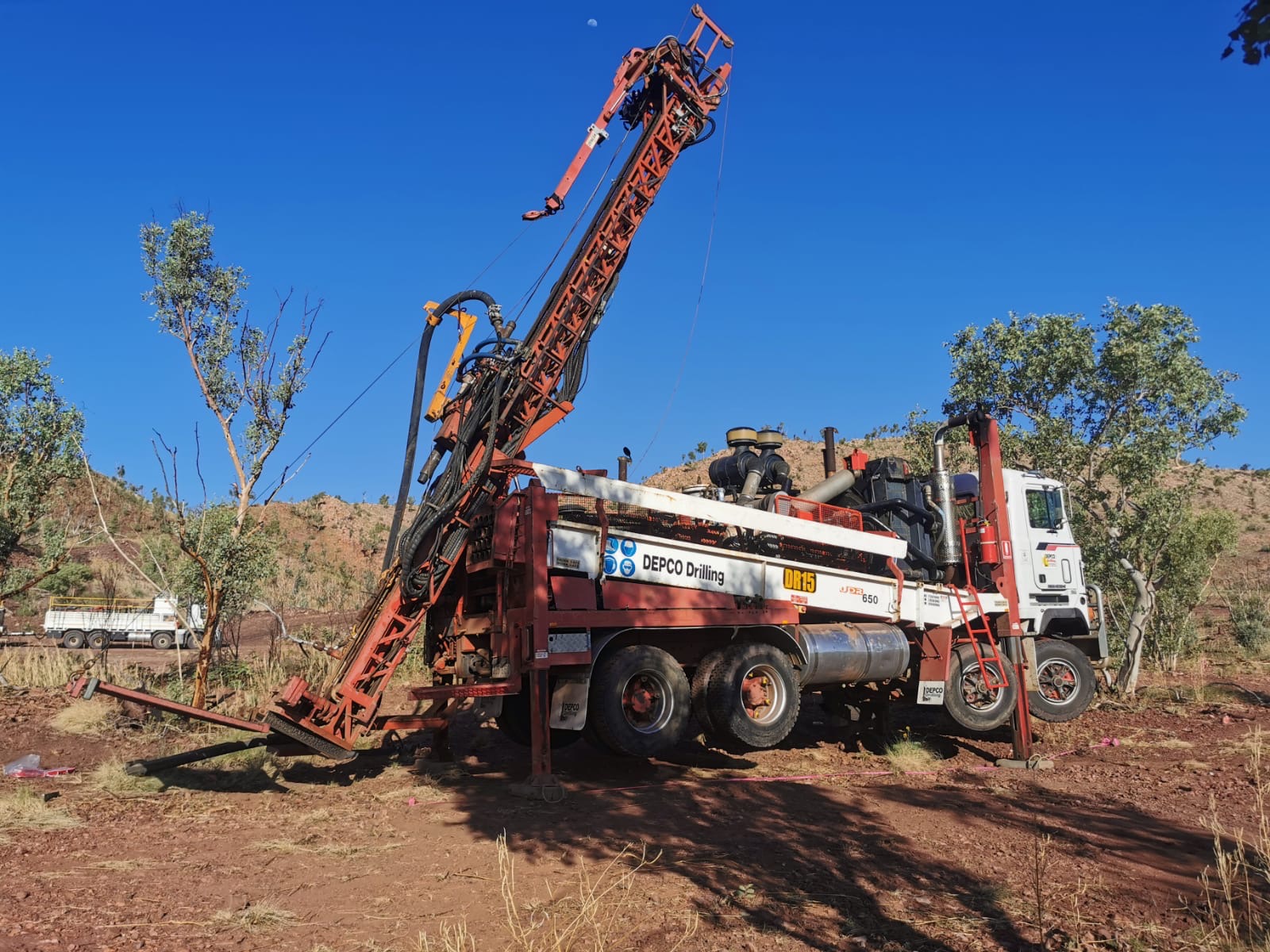- Drill-hole BO_318RC intersected significant visible copper mineralisation in two distinctive zones – 11m from 89-100m and 34m from 153-187m (apparent thickness):
- Notably, massive copper sulphide mineralisation –chalcopyrite and chalcocite – was clearly observed
- More significantly, all seven drill-holes completed in the campaign so far, through visual inspection, have appeared to intersect copper mineralisation – the best intercepts are shown in Figure 1 below:
FIGURE 1: BEST INTERCEPTED MINERALISATION
| Borehole | From (m) | To (m) | Apparent Thickness (m) | ||||||||||||||||||||||||||||
| BO_318RC: | 89 | 100.0 | 11.0
| BO_318RC: |
153.0 | 187.0 | 34.0
| BO_319RC: |
55.0 | 64.0 | 9.0
| BO_321RC: |
63.0 | 72.0 | 9.0
| BO_315RC (1): |
61.0 | 69.0 | 8.0
| BO_316RC (1): |
113.0 | 120.0 | 7.0
| BO_316RC (1): |
129.0 | 146.5 | 17.5
| BO_317RC (1): |
90.5 | 103.0 | 12.5 |
|
Note: Results for drill-holes 315-17RC published on 29 June 2021
- Reconciling these new data points with the geological modelling completed to date, clearly verifies material extensions to known mineralisation and potentially a larger underlying system then initially envisaged
- A key feature behind the success of the current campaign has been the significantly improved targeting, resulting from the effective utilisation of geophysical insights (2) to refine and reshape the drilling program to boost the collective exploration potential
- All samples from drill-holes BO_318-21RC are currently with the laboratory for analysis, while results from BO_315-317RC are expected to be received imminently
Castillo Copper’s Managing Director Simon Paull commented: “Hitting copper mineralisation seven times from seven starts is an outstanding way to progress the drilling campaign at the Big One Deposit. Moreover, the result from drill-hole 318RC is excellent, throwing off two zones of visible mineralisation totalling 45m and confirms massive copper sulphides are apparent. In addition, the Board is delighted there is clear evidence that known copper mineralisation has been extended and looks forward to releasing interpreted insights from upcoming assays results.”
Castillo Copper Limited (“CCZ”) is pleased to report copper mineralisation was intersected in drill-holes BO_318-21RC at the Big One Deposit in Mt Isa’s copper-belt, which complements the results from BO_315-317RC announced on 29 June 2021 (Figure 2 & Appendix A)(1).
VISIBLE COPPER MINERALISATION
Significant results continue
The latest results for drill-holes BO_318-21RC were positive, as all intersected visible copper mineralisation. Drilling down, the standout drill-hole was BO_318RC which, from visual inspection, appears to have intersected copper mineralisation in two distinct zones – 11m from 89-100m and 34m from 153-187m (apparent thickness). In a further positive development, which makes the Big One Deposit’s case even more compelling, massive copper sulphide mineralisation – chalcopyrite and chalcocite – were observed.
In addition, the results for drill-holes BO_319RC and BO_321RC were encouraging, as both intersected 9m of visible copper mineralisation at relatively shallow depths.
FIGURE 2: BIG ONE DEPOSIT – QUALITATIVE ASSESSMENT OF DRILLHOLES 315RC-321RC
| Borehole | From (m) | To (m) | Apparent Thickness (m) | Comments | |||||||||||||||||||||||||||||||||||||||||||||||||||||||||||||||||||||||||||||||||||||||||||||||||||||||||
| BO_318RC: | 89.0 | 100.0 | 11.0 | Dacitic
| BO_318RC: |
153.0 | 187.0 | 34.0 | Dacitic, some orthoclase
| BO_319RC: |
55.0 | 64.0 | 9.0 | Dacitic, some orthoclase
| BO_319RC: |
83.0 | 84.0 | 1.0 | Quartzite
| BO_319RC: |
87.0 | 91.0 | 4.0 | Dacitic
| BO_319RC: |
96.0 | 98.0 | 2.0 | Dacite
| BO_320RC: |
79.0 | 80.0 | 1.0 | Quartzite, some orthoclase
| BBO_321RC: |
63.0 | 72.0 | 9.0 | Dacitic
| BO_321RC: |
86.0 | 88.0 | 2.0 | Quartzite
| BO_321RC: |
97.0 | 100.0 | 3.0 | Quartzite
| BO_315RC(1): |
958.0 | 61.0 | 2.0 | Quartzite
| BO_315RC(1): |
61.0 | 69.0 | 8.0 | Trachyte to porphyry dacite
| BO_315RC(1): |
69.0 | 71.0 | 2.0 | Quartzite
| BO_316RC(1): |
113.0 | 120 | 7.0 | Quartzite
| BO_316RC(1): |
129.0 | 146.5 | 17.5 | Trachyte to porphyry dacite
| BO_317RC(1): |
11.0 | 13.0 | 2.0 | Haematite-rich shale
| BO_317RC(1): |
20.0 | 24.0 | 1.0 | Quartzite; pyrolusite
| BO_317RC(1): |
42.0 | 43.0 | 1.0 | Quartzite; pyrolusite
| BO_317RC(1): |
65.0 | 66.0 | 1.0 | Quartzite; pyrolusite
| BO_317RC(1): |
75.0 | 76.0 | 1.0 | Siltstone; potassic alteration
| BO_317RC(1): |
90.5 | 103.0 | 12.5 | Andesite dyke, plus sericite and chrysocolla
| BO_317RC(1): |
103.0 | 105.0 | 2.0 | Quartzite |
|
Notes:
- Samples have been taken at 1m intervals;
- Mineralisation estimated from field geologists rock-chip estimates;
- True vertical depths will be calculated by Minescape block model procedures;
- A zone of limited mineralisation inferred to be associated with the dyke was intersected in each deepened drill hole; and,
- In borehole BO_317RC, the dyke was intersected at a shallower depth than predicted; hence, there was no requirement to drill the bore to the estimated total depth of 150m.
Source: CCZ geology team
Overall, when factoring in BO_315-17RC, all seven drill-holes completed so far in the campaign have intersected visible copper mineralisation. This is an encouraging start, considering there are still a further 19 drill-holes to complete in the current program.
Known mineralisation extended
Leveraging the insights from the recent Induced Polarisation (IP) survey (2) has been a key feature in improving the drilling results for this current campaign, as targeting has been greatly enhanced.
Consequently, the geology team are now able to verify the following issues with a higher degree of conviction:
- The findings from drill-holes BO_315RC-21RC suggest the underling copper mineralisation at the Big One Deposit is controlled by structural trends. This is positive, as it potentially means the mineralisation constrained within the trachyte/dacite dyke is a secondary feature.
- Reviewing and reconciling the latest data points with the geological modelling undertaken so far clearly verifies significant extensions to known mineralisation. Moreover, the clear follow-on implication is potentially a larger underlying system then initially envisaged.
- A program of mapping and rock chip sampling is contemporaneously occurring along each of the five IP survey lines (refer to the photo gallery below – LHS & Appendix B).
- The use of surface and downhole geophysical interpretations for this current campaign has been
a critical factor that has enhanced the exploration potential at the Big One Deposit.
PHOTO GALLERY – DRILLING TEAM AT BIG ONE DEPOSIT


Source for photo 1 and 2: CCZ geology team [Location: 7,880,306E, 335,422N]
Next steps
There are several ongoing steps, including:
- Assay results for BO_315RC-317RC are due back from the laboratory imminently.
- Samples for BO_318RC-321RC have been dispatched for follow up analysis.
- The drilling campaign continues at Big One Deposit with a further 19 drill-holes to complete.
- Finalise logistics, access, cultural heritage, and targets for the drilling campaign at the Arya Prospect.
References
- CCZ ASX Release – 29 June 2021
- CCZ ASX Release – 20 May 2021

